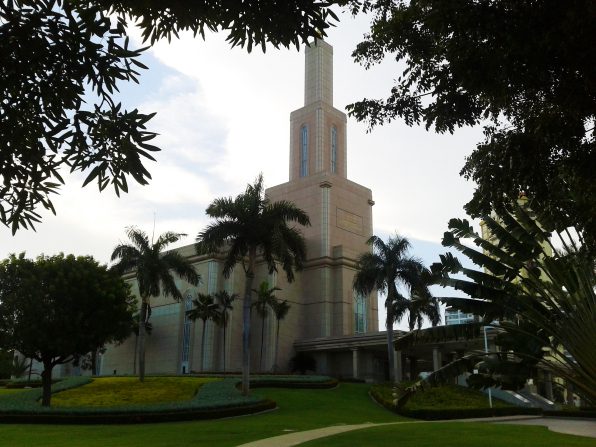
Some critics insist that the Church of Jesus Christ of Latter-day Saints is nothing more than a profit-driven corporation designed to enrich its leaders. This charge is absurd on its face, of course, but it surely ought to be obvious that the Dominican Republic isn’t very likely to be a profit center for the Church. And Haiti, next door, where a new temple is under construction, is even LESS likely. For a bunch of supposedly greedy corporate executives, Church leaders certainly seem to be taking a lot of interest in “investments” that will never pay off financially.
As a former director of the Center for the Preservation of Ancient Religious Texts (CPART), a division of what was then FARMS but later became the Maxwell Institute, and as someone who was present at the very creation — indeed, as a former chairman of the board of FARMS who was closely affiliated with the organization for twenty-four years — I’m saddened to see this:
“CPART’s season at the Maxwell Institute comes to an end”
Those were heady days. We had high hopes; fantastic relationships internationally; grand ambitions; generous, supportive, and involved donors; and a remarkable symbiosis of enthusiastic BYU specialists in both ancient studies and cutting-edge electronic technology. BYU was a world leader, a central player. There was a spirit of adventure and excitement about the whole FARMS organization. To repurpose the opening lines of William Wordsworth’s rather oddly-titled poem “The French Revolution as It Appeared to Enthusiasts at Its Commencement”:
***
From the hellish region of California’s terrible fires:
“Watch: Why woman displaced by Calif. wildfires is feeding other victims at Mormon chapel”
***
From the Salt Lake Tribune, historically hostile to the Church of Jesus Christ of Latter-day Saints and its leaders and, still today, often critical:
“Records reveal how money from Utah and U.S. Mormons props up LDS operations overseas”
This article is actually fairly balanced — though Gina Colvin, cited in the article, is scarcely a friend to Church leadership.
(For the Port-au-Prince Haiti Temple, see here: http://ldschurchtemples.org/portauprince/)
***
I’ve always been bemused, incidentally, by the complaint that I’ve long heard — and that I’m hearing a great deal again over the past few days — that the Church allegedly gives so little of its “profits” (that’s the word that’s often used to describe its income from tithes and other sources) for “charity.”
Sigh.
The Church of Jesus Christ of Latter-day Saints is a charity.
And tithes and fast offerings and the like aren’t “profits.”
The people making this complaint — relatively few of them, I suspect, actual tithe payers themselves — seem to imagine that welfare and humanitarian aid are the only activities or expenditures that can be validly counted as “charities.” But ordinary usage (not to mention American tax law) recognizes such organizations as the Sierra Club, the Metropolitan Opera Association, the Boy Scouts, the Museum of the Bible, Harvard University, the Audubon Society, the YMCA, the American Cancer Society, the Nature Conservancy, the American Civil Liberties Union, Junior Achievement USA, the Metropolitan Museum of Art, the Public Broadcasting Service, Wycliffe Bible Translators, the Smithsonian Institution, and the American Museum of Natural History as charities. Yet I doubt that most of those organizations devote a significant portion of their income to the digging of water wells in Africa or the alleviation of poverty in Appalachia.
The Metropolitan Opera Association is a charity that raises money to support . . . opera. Harvard University seeks donations to expand and deepen its educational offerings and its research, and to continue to build its (elite) international reputation. Wycliffe Bible Translators concentrate on . . . well, Bible translation.
In an analogous way, the Church of Jesus Christ of Latter-day Saints constructs temples, builds chapels, supports educational institutions (from seminaries and Institutes of Religion through universities) and subsidizes students, furthers international missionary work, pursues the gathering of genealogical records around the world, makes family history materials available at no charge, furnishes weekly broadcasts of “Music and the Spoken Word,” and a host of other things.
True, the critics don’t like those things. They regard those things as silly, if not worse. But that doesn’t mean that they’re not charities.
“Someone,” I read this morning, “is getting very rich off the tithes and offerings of Mormonism’s dupes.”
I have no idea, though, who that person might be. I alluded to such allegations only yesterday:
“The Church and Its Money, and David Whitmer’s Testimony, Versified”
I’ve addressed this general topic, of the Church and its humanitarian efforts, on a number of occasions. Here are just two of them:
“Why does the Church give so little to charity?”
“Another note regarding the disdain shown in some quarters for Mormon humanitarian assistance”
Finally, one observation: If the Church is really all about monetary profits, why — see the Tribune article, above — is it so heavily invested in regions and countries that it needs to subsidize?
Are the greedy buccaneers who supposedly run the Church somehow under the misimpression that Haiti, for example, and the Democratic Republic of the Congo are affluent areas?










